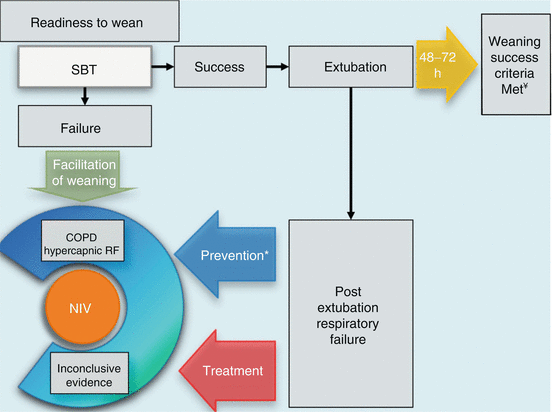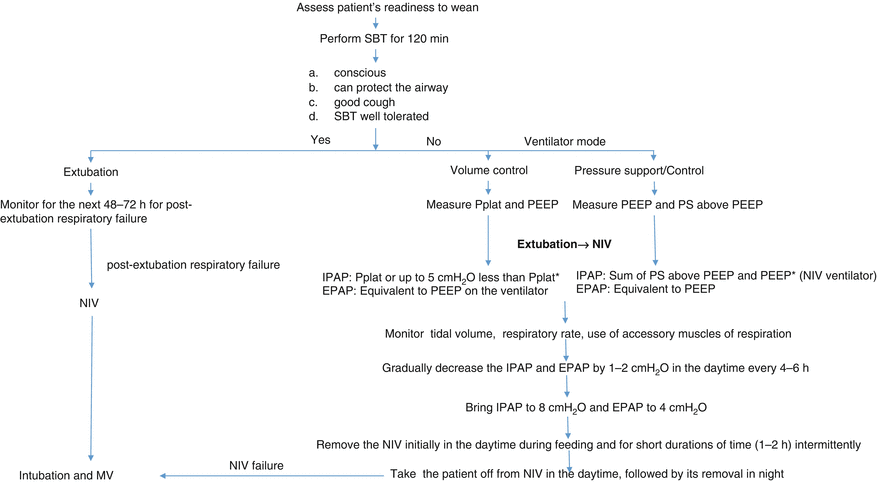Spontaneous breathing trial (SBT) failure
Clinical assessment subjective tools
Agitation and anxiety
Depressed mental status
Cyanosis, diaphoresis
Evidence of increased breathing effort
Nasal flaring
Excessive use of accessory muscles of respiration
Intercostals recession
Objective parameters
PaO2 ≤50–60 mmHg on FiO2 ≥0.5 or SaO2 <90 %
PaCO2 >50 mmHg or an increase in PaCO2 >8 mmHg
pH <7.32 or a decrease in pH ≥0.07
Respiratory rate/Tidal volume (RSBI) >105 breaths/min/l
RR >35/min or increased by ≥50 %
Heart rate >140/min or increased by ≥20 %
Systolic BP >180 mmHg or increased by ≥20 % or <90 mmHg
Cardiac arrhythmias
18.3 Etiology and Pathogenesis of Difficult Weaning
Difficult weaning occurs in around 25 % of intensive care patients and in 40–60 % of patients with chronic obstructive pulmonary disease (COPD). Reintubation may be needed within 48–72 h in 5–25 % of elective extubations, even after a successful SBT. Reintubation is an independent factor in nosocomial pneumonia, mortality, and intensive care unit (ICU) and hospital stay.
A wide number of reasons are attributed to difficult weaning (Fig. 18.1). It includes partial resolution of the initial pathology leading to intubation or the development of a new disease. Respiratory (28 %) and cardiac failure (23 %) have been cited as among the commonest causes of reintubation. Aspiration and excessive secretions account for nearly 16 % of causes. Anemia and neuropsychological, metabolic, and nutritional factors may also contribute to a delay in weaning.


Fig. 18.1
Determinants of difficult weaning
Patients with difficult weaning usually develop a rapid and shallow breathing during the SBT. Prediction of successful SBT is most commonly assessed by calculating the rapid shallow breathing index (RSBI). It is the ratio of respiratory rate per minute to tidal volume generated by patient in liters. A value of less than 105 breaths/min/l has a sensitivity of 0.97 and a specificity of 0.65. In patients with chronic obstructive airway disease, a shift from positive pressure ventilation to spontaneous breathing leads to increased stress on the respiratory muscles, with a progressive rise in dynamic elastance and inspiratory resistance of lung. This leads to development of auto-positive end-expiratory pressure (auto-PEEP) and increased work of breathing. Due to progressive increase in dynamic hyperinflation, the respiratory muscles work at greater mechanical disadvantage with subsequent fall in capacity, which can decrease further by the development of acidosis. The cardiac stress during the transition of the positive pressure ventilation to spontaneous breathing is vital to avert weaning failure. There occurs a rise in venous return to the right ventricle, leading to displacement of interventricular septum to left side due to ventricular interdependence. An increase in negative intrathoracic pressure due to raised inspiratory threshold leads to a subsequent rise in left ventricular afterload. Inadequate cardiovascular response to these alterations leads to left ventricular failure, raised pulmonary artery occlusion pressure, and elevated brain natriuretic peptides, resulting in weaning failure.
Noninvasive ventilation is a mode of positive pressure ventilation that administers ventilatory support to the patient’s upper airway using a mask or similar device. It is increasingly advocated for the weaning of patients from mechanical ventilation and post-extubation respiratory failure. In patients with difficult weaning, NIV can be used as
1.
Alternative mode of weaning in cases of unsuccessful conventional weaning
2.
Treatment of acute respiratory failure following extubation (post- extubation failure)
3.
Preventive measure for reintubation following extubation
18.4 Physiologic Rationale for NIV in Weaning (Table 18.2)
Table 18.2
Physiologic effects of noninvasive ventilation in difficult weaning
IPAP/PSV | EPAP |
|---|---|
Airway diseases | Decrease work of breathing |
↑Alveolar ventilation | ↓Inspiratory threshold |
↑Inspiratory airway pressure | ↓DHI/auto-PEEP |
Slow and deep breathing pattern | ↓Dynamic airway collapse |
↓Transdiaphragmatic pressures | ↓Rebreathing of CO2 |
Chronic neuromuscular diseases | Improves oxygenation |
↑Inspiratory support | ↑FRC |
↑Central responsiveness to CO2 | ↑Alveoli recruitment |
Improved sleep architecture | ↓V/Q mismatch |
↓Transdiaphragmatic pressures | ↑Lung compliance |
Redistribution of lung water | |
Improves cardiac dysfunction | |
↓Left ventricular workload | |
↑Ejection fraction | |
↑Coronary artery oxygen content |
Noninvasive positive pressure ventilation (NIPPV) has positive effects on respiratory physiology and gas exchange. The improvement in hypoxemia and hypercapnia with NIPPV in patients with COPD is due to improved alveolar ventilation secondary to attainment of a slower and deeper breathing pattern with no alterations in ventilation-perfusion mismatch. NIV attenuates the fall in intrathoracic pressure, work of breathing with additive effects of positive pressure ventilation, and external PEEP. A reduction in diaphragmatic effort indices (transdiaphragmatic pressures and the pressure time product of diaphragm) is also seen after application of NIV. Thus, NIV is associated with attenuation of rapid shallow breathing, better gas exchange, augmented tidal volume, improved ventilation of alveoli, and reduced work of breathing. PEEP counteracts the auto-PEEP, which decreases work of breathing and alleviates the raised inspiratory threshold often present in patients with obstructive airway diseases and in patients with dynamic hyperinflation. It also improves oxygenation and prevents rebreathing of CO2. Putting a patient on T-tube as a part of weaning results in an immediate rise in transpulmonary arterial occlusion pressure. Noninvasive ventilation-induced positive intrathoracic pressure can avoid this by reduction in cardiac preload and afterload.
18.5 Use of NIV as an Alternative Mode in Conventional Difficult Weaning (Fig. 18.2)

Fig. 18.2
Noninvasive ventilation: current status in weaning from invasive ventilation. SBT spontaneous breathing trial, COPD chronic obstructive pulmonary disease, NIV noninvasive ventilation, RF respiratory failure. *NIV can be applied in patients with chronic pulmonary disease, chronic cardiac failure, old age >65 years, PaCO2 >45 mmHg, morbid obesity. †Criteria for post-extubation respiratory failure: RR >25/min for 2 h; heart rate >140/min or fall by >20 %; signs of respiratory distress: SaO2 <90 %, PaO2 <80 mmHg on FiO2 ≥0.5; PaCO2 >45 mmHg or ≥20 % from pre-extubation; pH < .33. ¥Weaning success criteria: SaO2 >90 %; FiO2 >0.4; pH >7.35; RR <25/min, conscious

Fig. 18.3
Weaning protocol by Non-invasive ventilation in difficult weaning. SBT Spontaneous breathing trial, Pplat Plateau pressure, PEEP Positive end expiratory pressure, PS Pressure support, IPAP Inspiratory positive airway pressure, EPAP Expiratory positive airway pressure, NIV Non-invasive ventilation, MV Mechanical ventilation. *IPAP and EPAP are terminologies of BiPAP (Bilevel positive airway pressure) machine. In ICU ventilators: Pressure support above PEEP is equivalent of IPAP; PEEP is equivalent of EPAP. Set PS above PEEP = Pplat or up to 5 cmH2O less than Pplat or pre extubation PS above PEEP. Set PEEP =pre extubation PEEP
Numerous studies have suggested that NIV could assist in weaning patients from invasive ventilation. A short weaning time and prevention of reintubation could be primary end points where NIV is indicated in patients with failed weaning efforts from mechanical ventilation. Udwadia et al. [2] evaluated the role of NIV in 22 patients with difficult weaning. Nine patients had primary lung pathology or chest wall disease, and six had neuromuscular pathology. With nasal NIV, after a median of 11 days, 18 patients were successfully weaned from invasive ventilation. The first randomized controlled trial (RCT) for evaluation of NIV in weaning in patients with acute exacerbation of COPD with severe type II respiratory failure who had recovered within 48 h of mechanical ventilation, but had failed SBT, randomized the patients into two groups [3]. The first group continued to be intubated with weaning by pressure support ventilation mode while the second group was extubated and put on NIV. Patient on NIV had a significantly shorter duration of ventilation, a lower incidence of nosocomial pneumonia, increase in survival by 60 days, and were more likely to be successfully weaned (88 % vs 68 %). The authors concluded that shortening the duration of endotracheal intubation was the main cause of reduced incidence of ventilation-associated complications and mortality.
Stay updated, free articles. Join our Telegram channel

Full access? Get Clinical Tree



